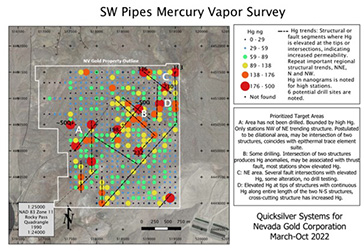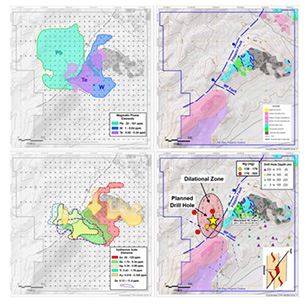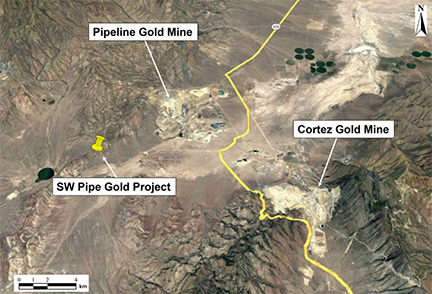The SW Pipe Gold Project is located in Lander County approximately 6 km (3.7 miles) southwest of the world-class Pipeline gold mine in the central Cortez gold belt of north-central Nevada (Figure 1). The Property, comprising 84 unpatented mining claims, is 100%-owned by NV Gold. Historical drilling established a near-surface, oxide-gold zone characterized by multiple intercepts of 15 m+ @ 0.5-1.0 g/t Au.
About the SW Pipe Gold Property:
Historical Work and Geology
- First-phase rock-chip sampling by NV Gold has returned gold values up to 1.74 ppm with high arsenic and antimony, elements enriched in productive Carlin-type gold deposits. Historic shallow drilling in 1989 yielded intersections that include 0.442 g/t over 16.8 min 89-1, 0.654 g/t over 15.2 m in 89-2, 0.794 g/t over 9.2 m in 89-9, and 0.580 g/t over 18.3 m in 89-11 (see Figure 3).
- Mineralization is largely within 100 m (328 feet) of surface and is hosted by siltstones and quartzite within the western-facies sequence (the upper-plate of the regional Roberts Mountains thrust fault).
- Preliminary results indicate that north-northwest-striking faults may have localized mineralization which also spread laterally away from these “feeder” faults in a stratiform style along a major geologic contact, possibly a thrust fault. The north-northwest striking faults have not been tested by drilling, and faults of this orientation are the key control to localizing gold mineralization along the Cortez gold belt, including the nearby Pipeline, Cortez Hill and Goldrush deposits, which contain at least 40 million ounces of gold.
Recent Work in 2022
- A total of 567 soil samples were collected on the Property and later modeled in MapInfo. The modeling shows a large and comprehensive zone of overlapping Carlin-type geochemical anomalies including gold, arsenic, antimony, mercury, thallium, and selenium, in the neighborhood and merging with a “Magmatic Plume”, which is characterized by strong lead, tungsten and tellurium (see Figure 3). (Note: The geochemical interpretation is referring to the “Geology and Geochemistry of the Deep Star Gold Deposit Model, Carlin Trend, Nevada,” published in Economic Geology by Robert Jackson and Co-writers in 2003.)
- It is important to mention, that all historical reverse circulation (“RC”) holes were drilled outside of the newly defined geochemical “feeder” target, and that in the past encountered near-surface, oxide-gold mineralization, can be representing leakage of a productive, deeper-seated Carlin-type gold system.
- The “New Feeder Target” is an interpreted dilational zone, at least half a kilometer wide and one kilometer long. The dilational zone is defined by two intersecting faults, the Filippini Fault and the north-west striking Magmatic Plume Fault, which could have functioned as a fluid pathway allowing an uprising gold-rich metal brine to create the extensive geochemical anomalism (see Figure 2 & 3).
- In addition to the soil geochemistry program, the Company conducted a mercury vapor survey on the Property that detected four outstanding mercury vapor anomalies with values up to 500 nanograms (see Figure 2). (Note: 500 nanograms are the upper limits of mercury vapor detection). The A-anomaly is considered the most encouraging target since it overlaps and confirms the previously established soil geochemistry target.
- NV Gold has permitted one drill site to test the geochemistry target in Q1 of 2023, subject to capital and drill rig availability (see Figure 3).
About Mercury Vapor (Quicksilver Systems)
The Quicksilver Systems proprietary technique uses mercury vapor to detect blind mineralization. Exploration for Carlin-type deposits has shown that this approach is effective through 30.5 m to 61 m (100 to 200 feet) of post mineral volcaniclastic sediments, and 91.4 m to 457.2 m (300 to 1500 feet) of pre-mineral but unaltered sedimentary lithologies. Mercury from oxidizing mineralization is collected on a silver strip. These collectors are analyzed, and the results are mapped. Mercury vapor values exceeding the local background of mercury indicate mineralization at depth. These anomalous areas are used to target drilling for concealed gold mineralization.
Thomas Klein, VP Exploration stated, “These are extremely exciting results based on my knowledge and experience of over 20-years of Carlin Trend exploration and targeting. I have been involved in numerous soil sampling programs and mercury vapor surveys over the last two decades and have not seen such a comprehensive and understandable geochemical anomaly for a long time. The pure dimensions of the geochemical anomalies and their structural constraints are very impressive and their proximity to world-class gold deposits on the Cortex Trend makes SW Pipe a prime candidate to be the next multi-million-ounce gold discovery in Nevada”.
“The close proximity to a larger operating gold mining complex operated by Nevada Gold Mines and the known low grade gold system present at the SW Pipe Gold Project, provides the opportunity for a major higher grade discovery at depth.
ed John Seaberg, CEO
Figure 1: SW Pipe Gold Project General Location Map

Figure 2: SW Pipe Mercury Vapor Survey and resulting Mercury Anomalies

Figure 3: SW Pipe Gold Project Soil Geochemistry and Dilational Zone Target (Feeder Target)

